After a million criticisms, doubts and debates about everything that happened around Gareth Southgate and the England team, before the start of the tournament, the nation has come together for a long 90 minutes, in which England played its first game of the World Cup against Iran, where again they scored six goals, the same as in the last tournament against Panama.
Much was said about what this game was going to be. Due to the low rhythm and poor performance of the English team in their matches prior to the World Cup, as well as what the group, the match and their low block meant for Iran, which could cause problems for an England team that lately was running out of ideas.
However, something surprising happened to many football and England fans. Southgate, normally adamant about their formation and structural changes before and during games, finally brought a change that on the pitch meant a lot to England, who played in a 4-3-3 formation that contained a lot of fluidity and chance creation for the majority of the match.
Iran, who held a rather rigid and solid block for 30 minutes waiting to counterattack with the movements of Mehdi Taremi, could not avoid being completely rolled by England after their first goal who simply seemed to be the only team on the pitch. In this tactical analysis, we dive into the tactics of both teams and see how Gareth Southgate’s England outsmarted Iran with a wide 6-2 result.
Lineups
Gareth Southgate, as we mentioned above, changed his common structure from a 3-4-2-1 to a 4-3-3, in which Jordan Pickford was once again chosen to guard the goal of the ‘Three Lions’ during the World Cup. Kieran Trippier on the right and Luke Shaw on the left were the full-backs, and Harry Maguire with John Stones completed the defence.
Declan Rice was the axis and balance of his team, accompanied by Mason Mount in the distribution, and by Jude Bellingham who was top and really contributed to this change of structure and roles on the pitch. Finally, in attack, Southgate decided on Sterling over the left, Harry Kane through the centre and Bukayo Saka wide open on the right wing.
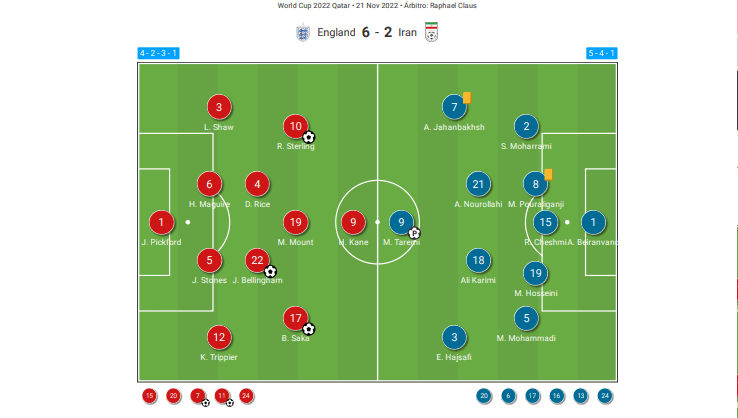
Carlos Queirós decided to go with a 5-4-1 with Alireza Beiranvand in goal, who later had to be subbed off thanks to a tough knock on his face against a teammate, Sadegh Moharrami and Milad Mohammadi were the wing-backs, accompanied through the middle by Rouzbeh Chesmi, Majid Hosseini and Morteza Pouraliganji. The midfield was then composed of a double-pivot with Ali Karimi and Ahmad Nourollahi, with Alireza Jahanbakhsh and Ehsan Hajsafi on the wings, while the well-known Taremi started up-front, who scored two goals.
Iran’s deep-block and how England unlocked it
Iran tried to execute their defensive plan from the overloads in the central zones with their 5-4-1, where one of the wingers moved in to load the central zone to block passing lines to Bellingham or Mount, which did not appear between the lines. All this happened and was successful if one of the midfielders of the double-pivot jumped towards one of the central players as well, following the inside movement of their winger.
Beyond the long stoppage of the match due to Beiranvand’s blow, England spent more than 15 minutes trying to break this block and Carlos Queiróz’s idea was largely working. The ‘Three Lions’ were moving the ball back and forth in defence and were unable to progress between the lines.
This example shows Iran’s attempt without the ball. One of the wingers (in this case the LW) left a player on the outside “alone” in a kind of trap (Trippier), in order to move to the middle and charge this area, blocking spaces where Bellingham, Rice or Mount could receive. While one of the midfielders accompanied Taremi to block Maguire in this case and when receiving, he could not turn the same side or progress between the lines.
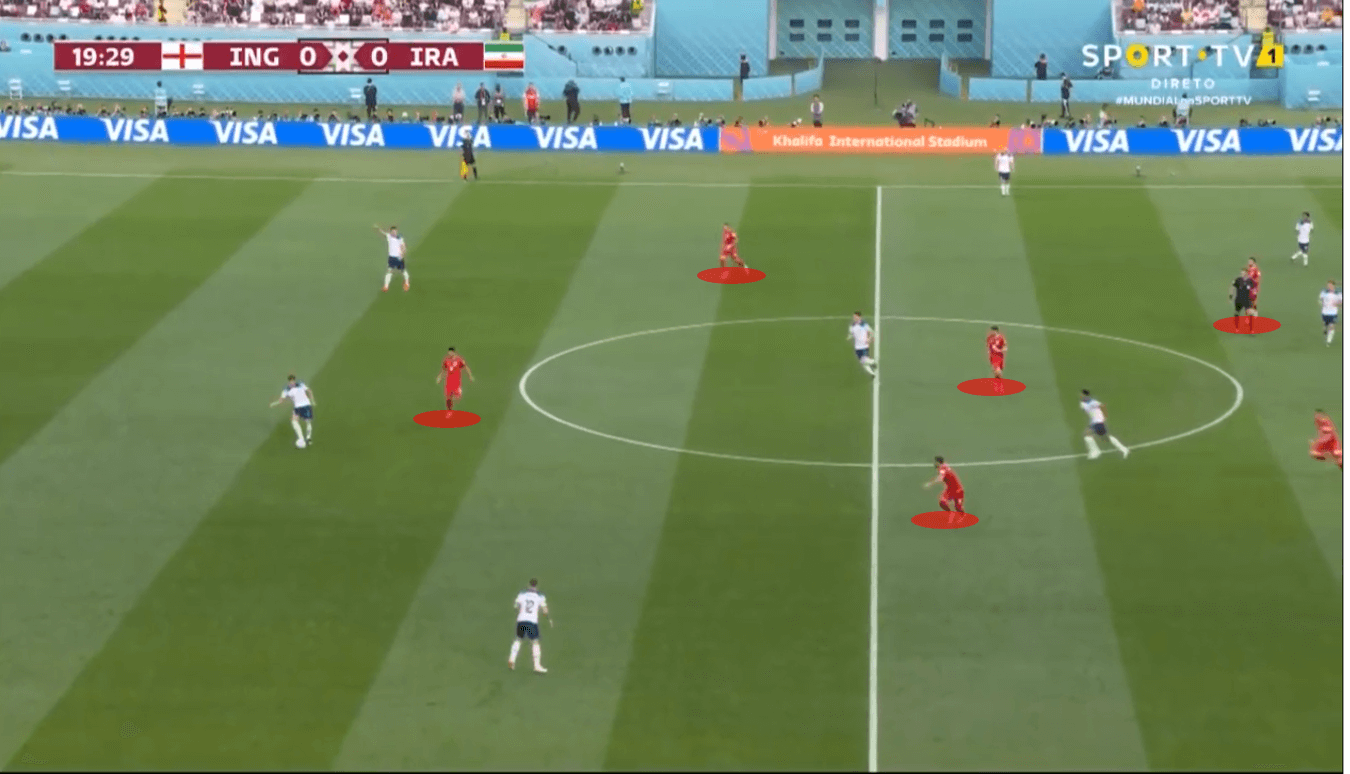
However, when one of these England midfield players made dynamic moves to lead his marker away and appear with space between the lines or in the half-spaces in more advanced zones, they created a lot of danger against an Iran block that was very soft and passive when they Southgate’s side successfully turned them into a deeper line.
Bellingham and Mount were responsible for this, thanks to their clever movements looking to receive the ball to progress from their receptions and ball controls. Even the first goal was scored in a similar way to what we show in the following image.
In just 5 minutes, England tried an escape route over this hard block of Iran that kept them overthinking how to evade it. Maguire, who with his progression was vital, found Bellingham who, given time and space, was able to completely turn his vision of the game around, where he saw Mount floating behind the midfield line. As one of the midfielders had to jump to put pressure on Maguire, if his return wasn’t correct, spaces were created to run. This was one of the first keys, in addition to Shaw’s position on the outside, which was outstanding with his executions at high speeds.
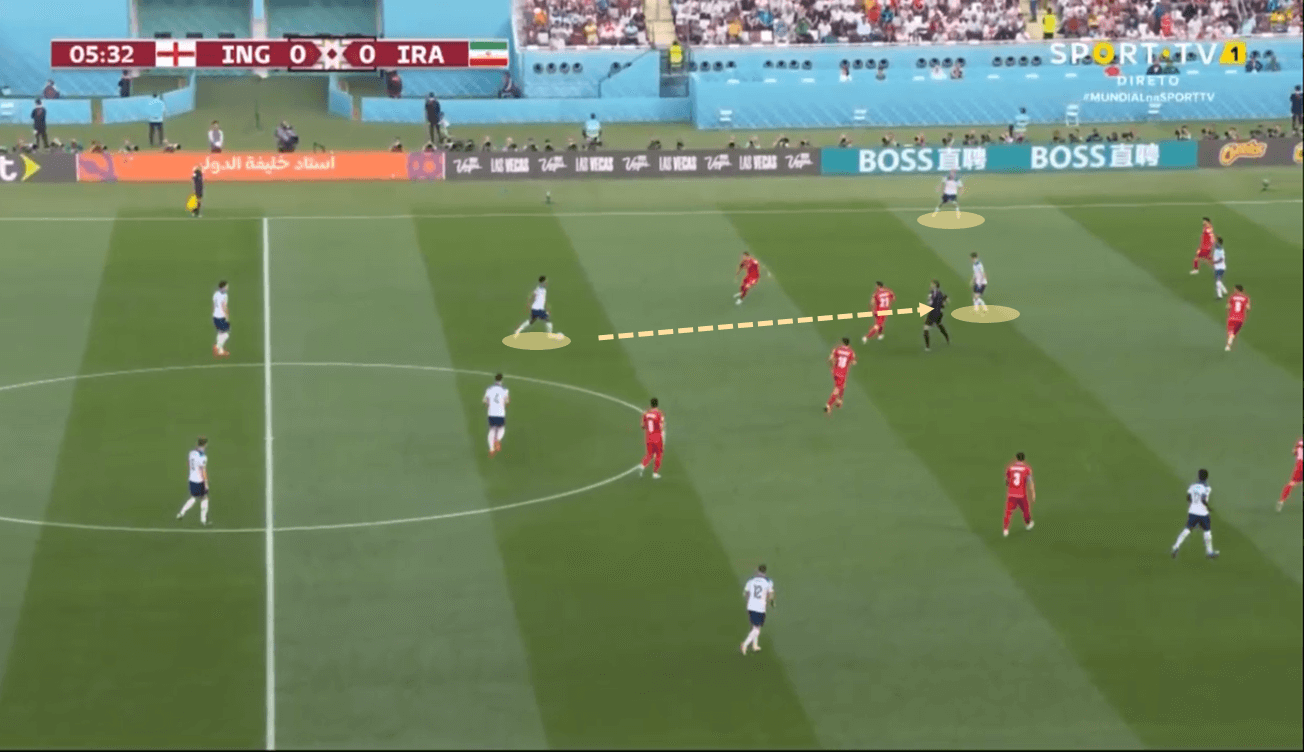
Another of the tactical moves that Gareth Southgate made was the inclusion of Kieran Trippier in a more centralized position rather than outside. Accustomed to a similar role in Newcastle, the right-back executed it brilliantly and just his simple presence in that area started to contribute to his team.
The reason is simple. Southgate knows that England is and will always be much more dangerous with a player like Bukayo Saka and his abilities in 1v1 playing wide. Therefore, Trippier’s decision in the half-space allows him to pin rivals there so that this pass, which can be seen in the picture below, can be executed, both by the central defenders and by Declan Rice. A nice little setup to start moving into the attacking third, where the channel exchanges were coming in vastly between Trippier and Saka.
This movement was also defensive-minded, as Kieran Trippier overloading the central areas and being part of the midfield with Declan Rice, would give more balance in a rest-defence shape to track-back in transitions and intercept passes or runs before they step on England’s third. As Bellingham and Mount would then be released in the final third, Southgate needed to find defensive balance aside all the field Rice can cover, so with the Newcastle right-back, he really found it.
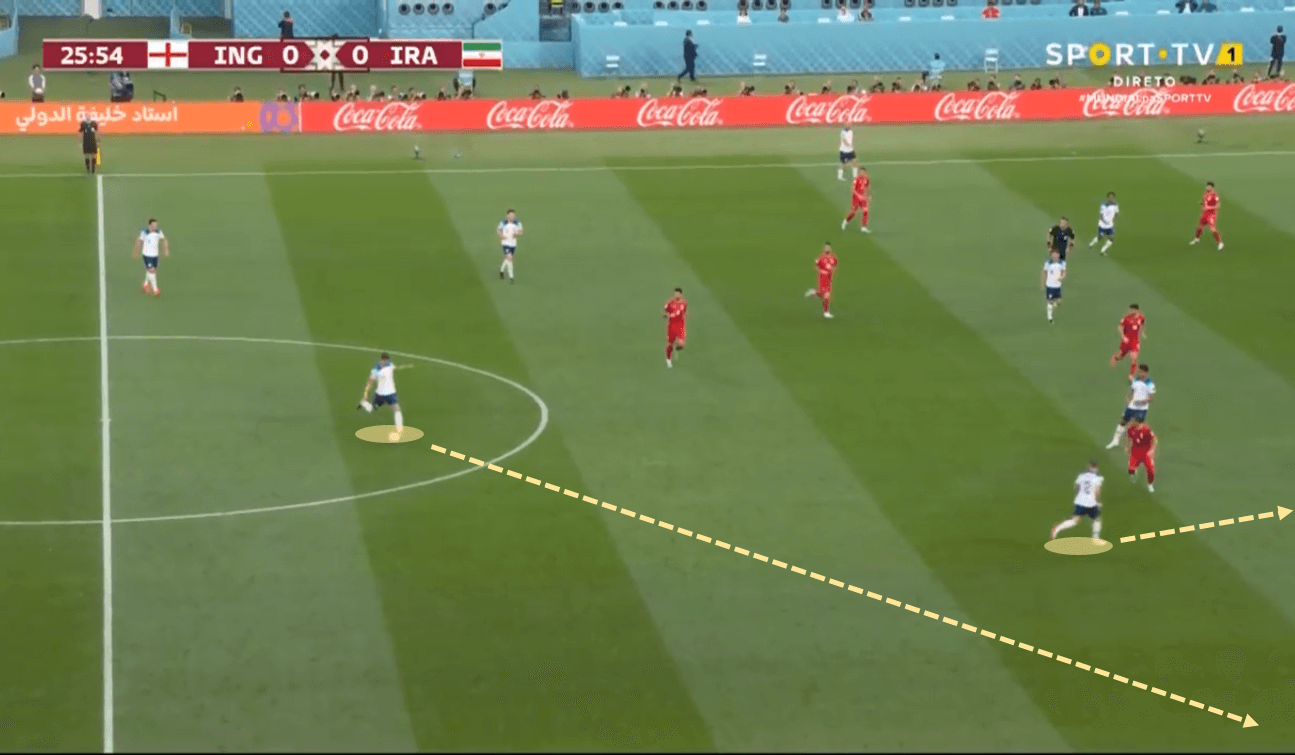
The key action for England to turn the game around was carried out in the build-up prior to the first goal. As Southgate’s men tried to generate triangulations over the right, with the dynamic exchanges of Trippier-Saka and Bellingham that usually accompanied them through the middle, the opportunity to turn the game around arose.
An important part of the play prior to the goal is that, after accumulating the ball for almost two minutes on one wing, Trippier was able to make a long pass to Maguire. With the Iranian block quite in disarray after this change of direction, Harry Maguire was the main man who, as we already mentioned, his ball-playing-ability was of paramount importance to England.
The image below shows what was the construction of the play with another tactical movement in which Raheem Sterling, with his descents and a more central position, pinned one of the Iranian midfielders so that Mount could have space between the lines. Maguire executed the pass excellently for the Chelsea player who made a quick touch with Sterling and his teammate immediately opened up the pass to the wing to Shaw, who sent a superb cross to Bellingham’s head.
Another turning point was noticed in this situation, as Bellingham’s goal was the demonstration that inside the role of being an arriving player to the box rather than a distributor, he would generate a lot of threat. After this, it was an absolute masterclass of passes, receptions, runs, and carries near or inside Iran’s penalty box by the Dortmund player.
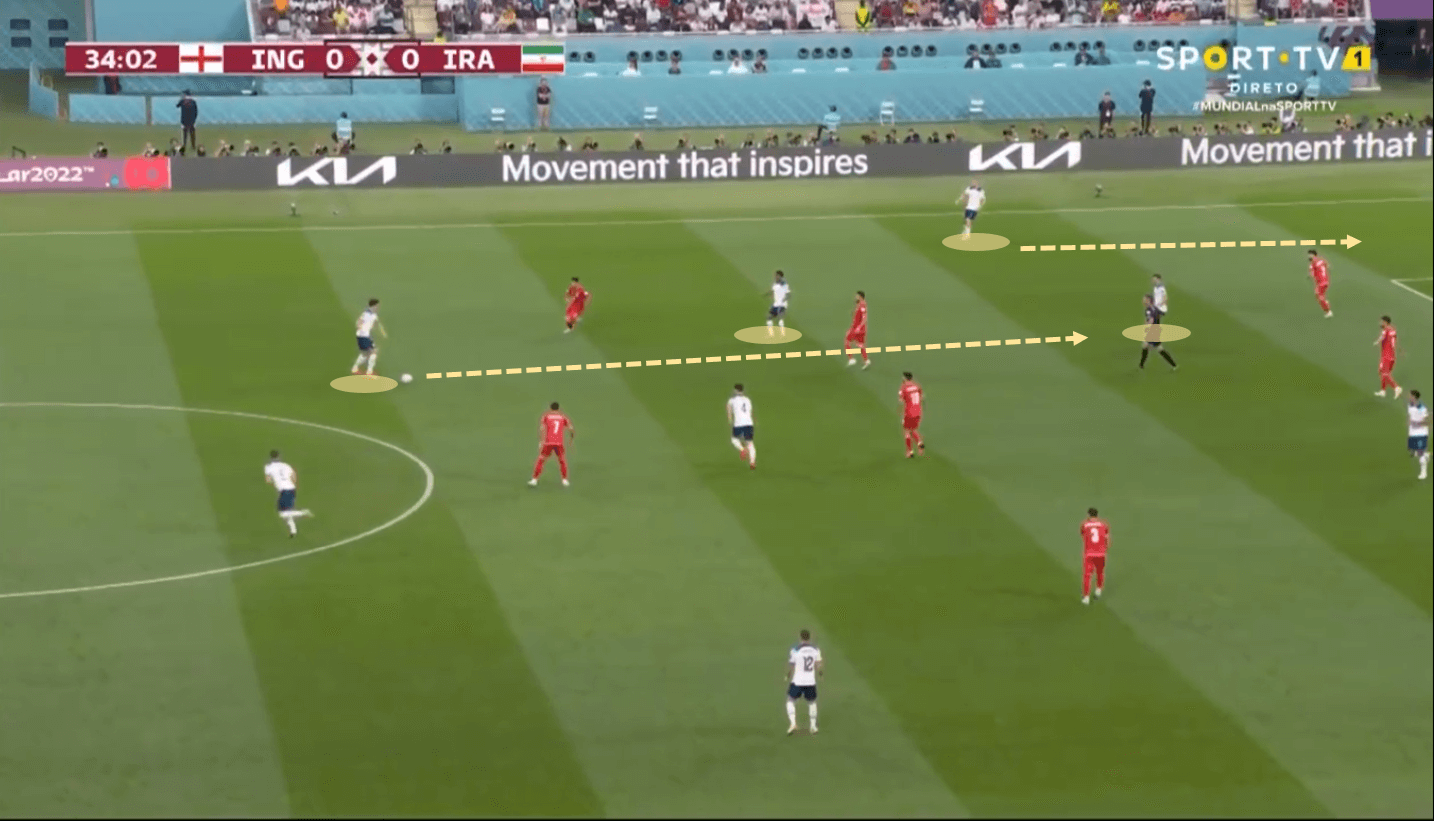
It is clear that the first goal opened the doors to a totally different match. After being down on the score, Iran had to try to reverse it with an idea that was more offensive than pragmatic, which was the polar opposite of what they were executing on the pitch for the first 30 minutes. The second goal came, once again, thanks to England’s set pieces, which proved to be still an important part of their game model.
Harry Kane’s role and spaces behind the midfielders
England finished the first half winning 3-0 against a totally devastated Iran that couldn’t react within a few minutes of Three Lions’ attacks. The third goal came thanks to the role and intelligence of one of the most important players in the match: Harry Kane. Despite not contributing with goals in the match, his associative facet and movements without the ball allowed England to generate a lot of danger, accompanied by Jude Bellingham who had a higher position on the pitch, and more space where he could start to shine his ball-carrying capacities. Things were even better for Southgate’s side.
Losing 3-0, Iran had to leave their comfort zone and their own third in search of more offensive football to get back into the game. Like Qatar in its first game two days ago against Ecuador, Iran found no solutions from the first or second passing lines. Neither the defenders nor the midfielders found ball circuits in which they participated in a natural and unforced way, where they hadn’t to burst the ball long to find solutions.
This overtaking of the block was clear in its risks. The idea was to look for a goal that could change the direction of the match, but by doing it in a way that they didn’t want, they were going to leave many spaces between their defence and midfield that, on many occasions of the match they had to run to try to stop the transitions of Kane, Bellingham, Sterling, Shaw, Mount and company.
The third goal was precisely the use of England in this match situation. With Harry Kane’s moves leaving his line to go down and get in touch with the ball, this spawned a lot of moves behind him, often between Saka-Bellingham-Sterling, which threw Iran into complete chaos.
The 3-0 was a sample of what Kane can do and what he has become when he descends into the passing circuits. He was able to contain his marker wonderfully at the back, before passing the ball to Bellingham, who drive with the ball inside with great ball retention and control technique, as well as physicality. The Tottenham striker’s off-the-ball movement was quite good, as he opened his run to the outside, dragged the marker and freed up space inside for either Sterling or Bellingham who reached the box.
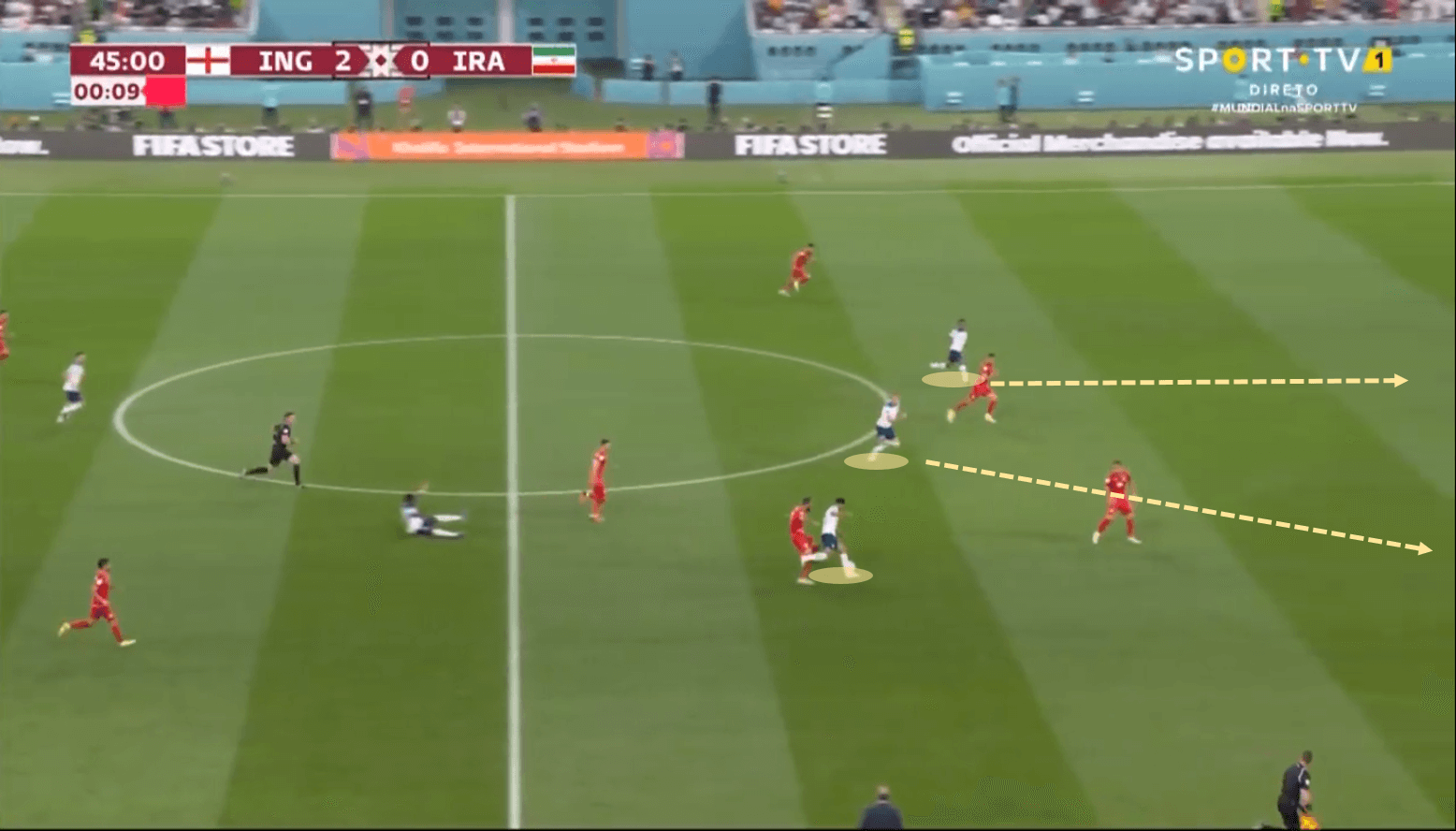
The second half was a total show of Harry Kane and his appearances between the lines. His participation in the build-up was getting better and more fruitful for England who felt very comfortable on the pitch running through the spaces behind the Iranian midfielders who could not counteract the level of speed, physicality and technique of those from Southgate’s side.
Again, the image below is one more detail Kane pulled off as he descended to freshen up England and make progress through the middle corridors, half-spaces and even outside channels of the pitch.
Raheem Sterling, in his inside role, was able to receive the ball and make a typical pace-change with his explosiveness, in which he found Harry playing with his back to goal. However, the English captain opened his body perfectly to execute a first-time pass that freed Sterling in a one-on-one race with one of the Iranian central defenders, who was able to contain him and block his pass. It was again for Kane that he even run to the penalty area accordingly.
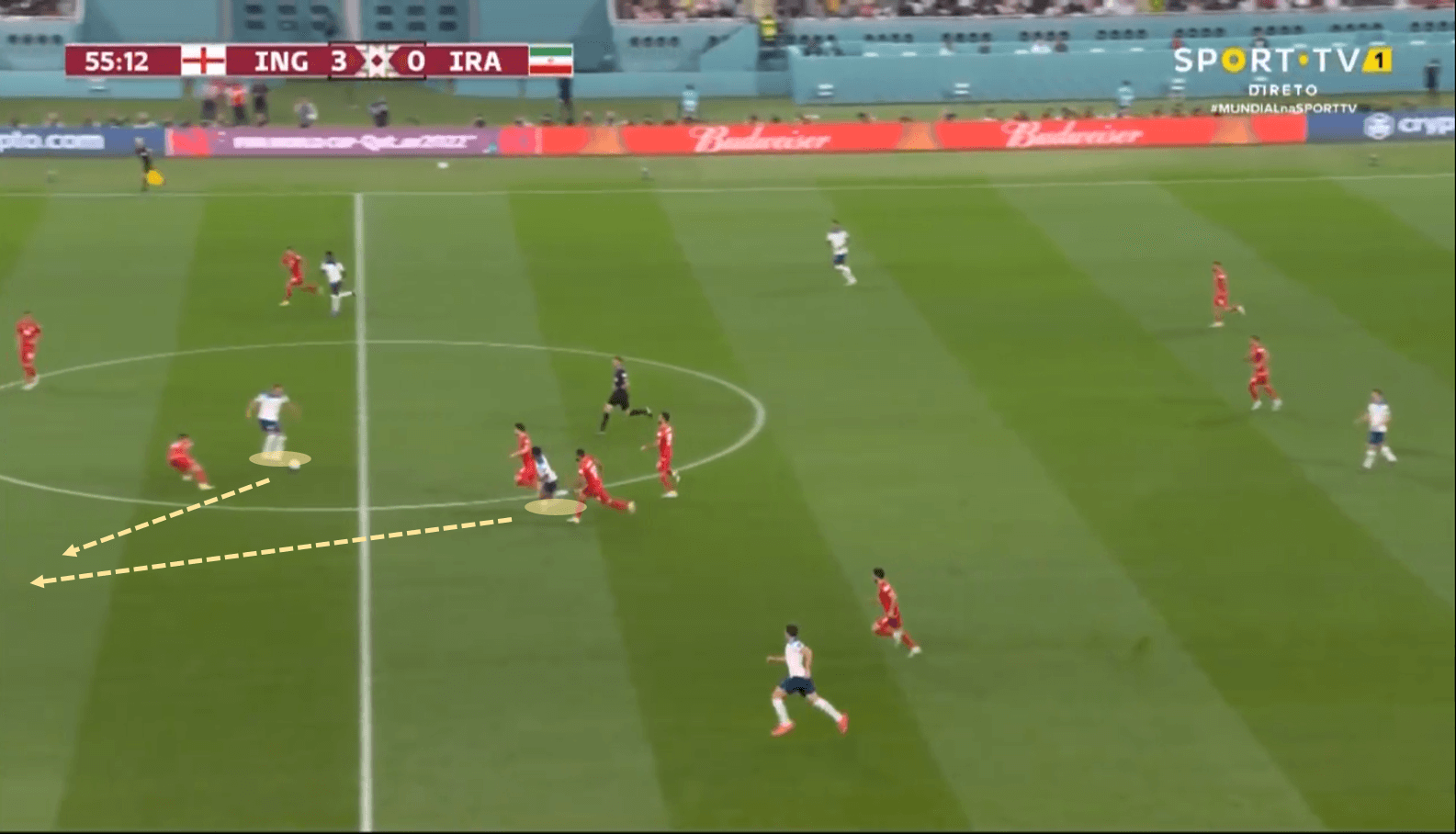
Another perfect example of Kane’s wonderful contribution to the team was in England’s fifth goal, where recently subbed-in Marcus Rashford made an excellent run behind his marker to receive a lethal through-pass from Harry Kane who brilliantly timed his partner movement to then release the execution with his right foot.
Before this sequence below happened, Kane again won a physical battle against an Iran defender, where he was able to control the ball, shield it and completely turn his body to face his common side, the right one, where Rashford was already at full speed waiting to receive the pass.
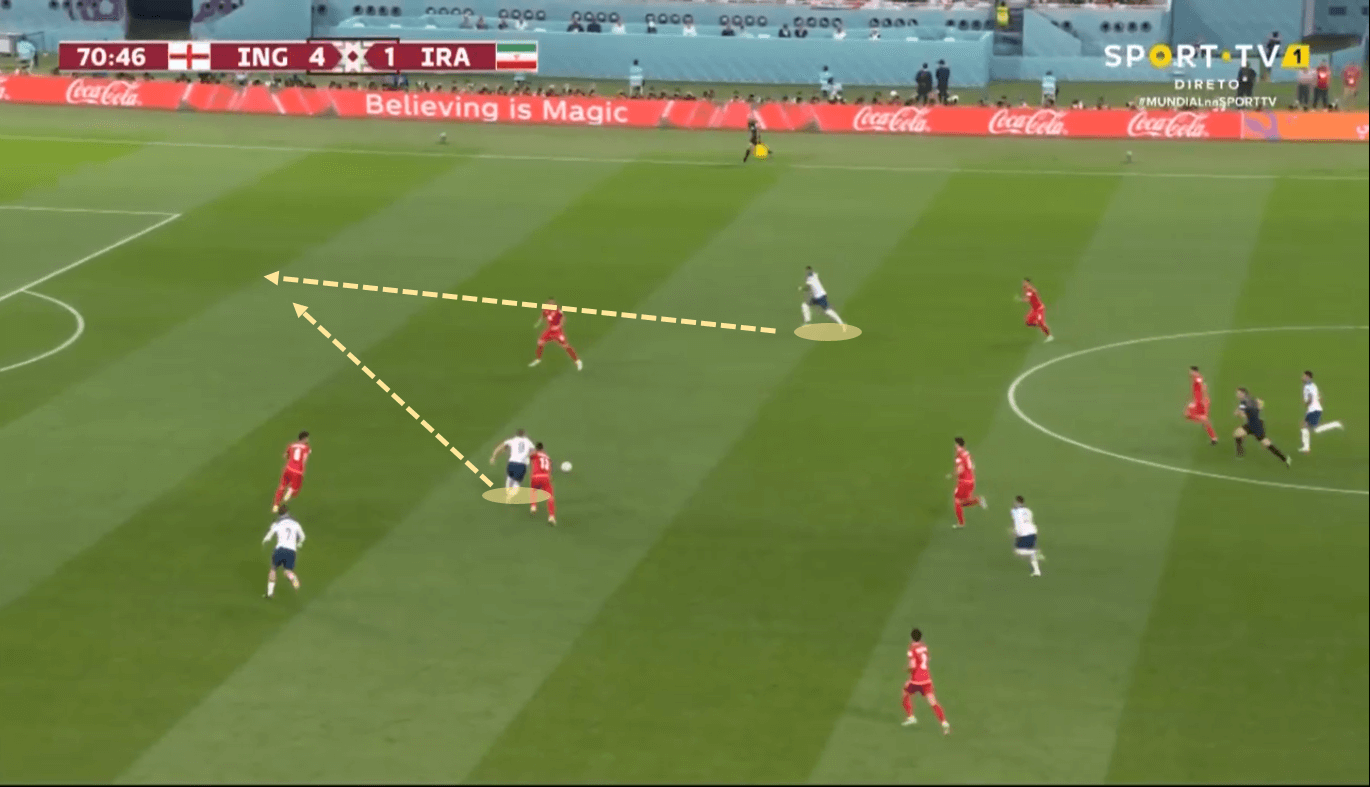
Not only was Harry Kane the player who appeared between the lines and took advantage of spaces, but he was undoubtedly one of the most brilliant in this regard. Players like Raheem Sterling or Jude Bellingham were also key with their internalised positions and their direct and fast carries after receiving a pass in these areas, which forcefully agitated the opponent, who, sequence after sequence, could not stop the English arrivals.
Conclusion
It is clear that England took advantage of their quality in every department, from defence to attack, against an Iran team that became very fragile and poor as the minutes passed. Individual performances such as those of Declan Rice, providing balance and covering each part of the field defensively, but also helping in the early stages of the elaborations with the ball, were on a very high level, as he usually does, which in each intervention provided a better collective context thanks to the understanding of each one of the eleven players in the starting lineup provided by Gareth Southgate.
As we saw in this analysis, their quality is beyond the normal levels of the game and they could really take advantage of these, where the collective doesn’t play that well.
Iran will have the consolation that they faced one of the toughest teams in the entire competition, however, their nation doesn’t expect them to give up that quickly on their interesting and physical game model against more equal teams in terms of level, like the United States or Wales.

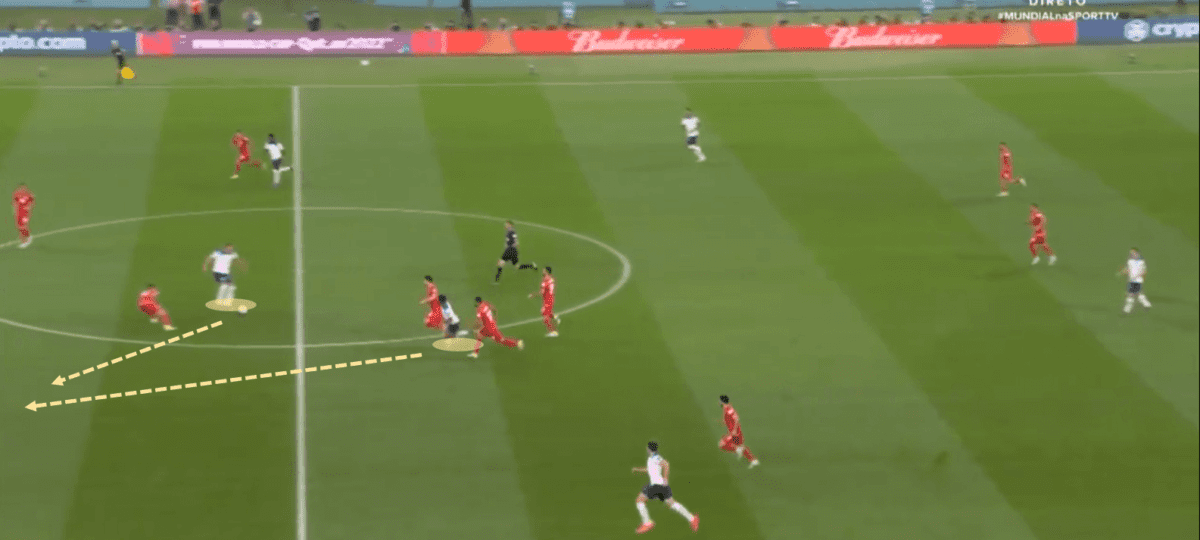




Comments